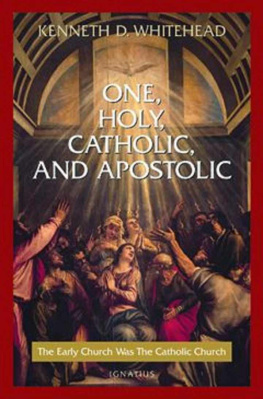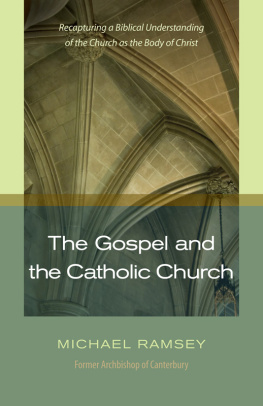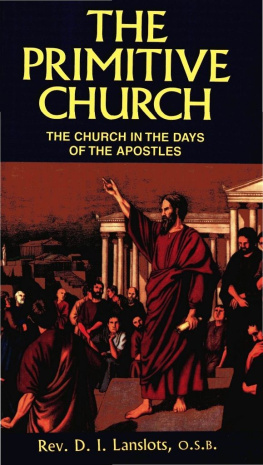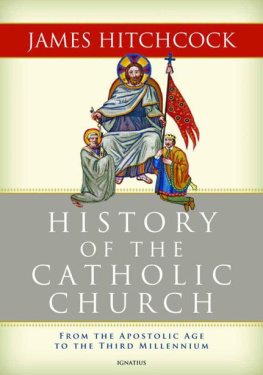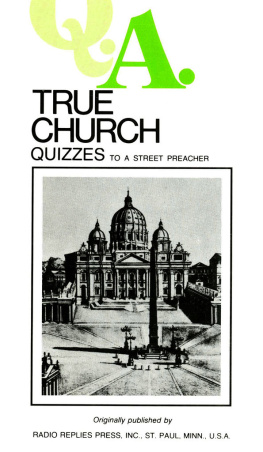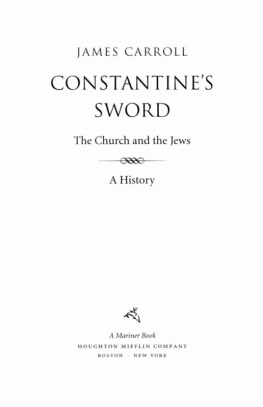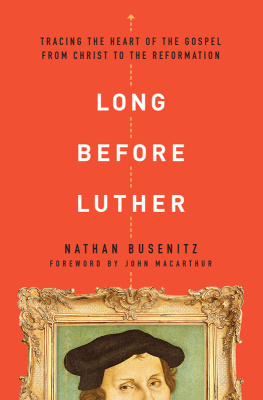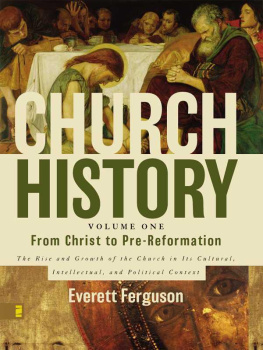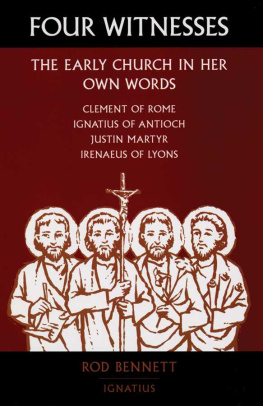ONE, HOLY, CATHOLIC, AND APOSTOLIC
KENNETH D. WHITEHEAD
ONE,
HOLY,
CATHOLIC,
AND APOSTOLIC
The Early Church Was the Catholic Church
IGNATIUS PRESS SAN FRANCISCO
Material in Chapters 1 and 2 and a portion of Chapter 3 previously appeared in This Rock . Material in Appendix I originally appeared in The Catholic Answer . Reprinted with permission of the publishers of these periodicals.
Cover art: Titian (ca. 1488-1576), The Pentecost
Santa Maria della Salute, Venice, Italy
Scala / Art Resource, New York
Cover design by Roxanne Mei Lum
2000 Ignatius Press, San Francisco
Reprinted 2007
All rights reserved
ISBN 978-0-89870-802-8
Library of Congress Control Number 00-100238
Printed in the United States of America
To
My nephew,
Father John M. ODonohue
Ordained to the sacred priesthood in the year 2000,
the Holy Year of the Great Jubilee
CONTENTS
INTRODUCTION
Very often in the history of Christianity, reformers, by whatever name, have aspired to return to the early Church. The Church of their own day, for whatever reason, fails to live up to what they think Christianity should be: in their view there has been a falling away from the beautiful ideals of the early Church, perhaps as expressed in such New Testament passages as this:
And all who believed were together and had all things in common; and they sold their possessions and goods and distributed them to all, as any had need. And day by day attending the temple together and breaking bread in their homes, they partook of food with glad and generous hearts, praising God and having favor with all the people. (Acts 2:44-47)
This blessed vision of peace and loving concord among the early Christians is understandably attractive, especially amid the labor, strife, worries, anxieties, exigencies, and compromises that characterize the daily lives of most of us. To yearn for the alleged perfections of the early Church is only too tempting for anyone who tries to take seriously the gospel of Jesus Christ but sees how regularly the authentic spirit of the gospel of Christ is set aside and forgotten, not only in the world around us, but, unfortunately, even by those who profess faith in Christ.
We do not need to exaggerate. Christianity has brought, and brings, many blessings into the world; it has brought, and brings, immense consolation and regular encouragement to those of us who have been given the grace of faith; it is all that enables many of us to live anything like a moral and hopeful life.
Nevertheless, we must never forget that although Christ conquered sin and death for us on the cross and has not ceased to share his divine life with us, especially through the sacraments of the Churchand while the Church through her appointed leaders does not cease to proclaim and expound the gospel of Christ to the worldthe world, nevertheless, continually falls far, far short of what a world redeemed by Christ and in possession of Christs words and works of truth and life ought to be.
Nor does the Church always manage to compensate for the worlds failings, in spite of the great good she does do. Far from it. Sometimes the Churchs inability to compensate here and now for the evil of the world stems from the failures of her members or former members, who ought to have been able to do better. Even where the seed has been sown, it sometimes fails to take root and grow and bear fruit, as Christ foretold in the parable.
This seems to have been true even in New Testament times. St. John, among others, was obliged to write about those who went out from us, but they were not of us; for if they had been of us, they would have continued with us... (1 Jn 2:19).
We must not judge the Church by the failures of her members, certainly not by those of her lukewarm or former members. We must bear with the Church in spite of human failings. We must remain with her precisely because she is the Church in which Jesus Christ himself willed that his words and works should be perpetuated throughout history. Our eternal salvation and hope of heaven, as well as our sanctification in this world, come from Christ through the Churchand they involve more than merely having a personal relationship with Jesus, calling upon his name, or simply accepting him as our personal savior: he it is who wills that we also be members of what St. Paul the apostle consistently called his body, the Church (cf. Col 1:18).
The Church is the community of believers in Christ, to be sure, but she is more than that; she is what in history has been called a visible Church, whose members subscribe to her creed and are subject to the authority of her hierarchyjust as the Christians of the first generation accepted the preaching of the apostles and were subject to their authority (as can abundantly be seen in the Acts of the Apostles).
Nor is the Church Christ wills we be members of some ideal body existing nowhere outside the pages of the New Testament. The Church is a living entity, established by Christ in New Testament times, continuing from that time to this, making available to successive generations the salvation and sanctification promised and provided by Christ.
It is the task of each successive generation of Christians in the Church to try to live the spirit of the Gospels. It is most decidedly not the task of each successive generation of Christians to try every so often to reestablish the Church anew, perhaps along the supposed lines of the early Church. It may be tempting to think that whatever we do not like about the Church today or think should not be part of Christs Church must therefore not have been part of the early Churchwe may be in for a surprise when we decide to look more closely and carefully at the early Church.
For the early Church has not disappeared. She is with us still. Reformers, again by whatever name, are not so much needed by this Church as are those who aspire to be saintsthose who are determined to follow Christ seriously and to fulfill Gods holy will by employing the means of sanctification that Christs Church continues to provide.
The visible body that today bears the name the Catholic Church is the same Church that Christ established to perpetuate in the world his words and his worksand his own divine lifeand to bring salvation and sanctification to mankind. Despite superficial differences in certain appearancesand just as an adult differs from a child in some appearances but still remains the same personthe worldwide Catholic Church today remains the Church that was founded by Jesus Christ on Peter and the other apostles in the first century in the Near East. The early Church wasalways!nothing else but the Catholic Church.
Chapter 1
THE CHURCH OF THE APOSTLES
I.
Around the year 58 A.D., Claudius Lysias, a Roman tribune serving in Jerusalem, was forced to intervene with a detachment of troops to save a local man from being savagely beaten by an enraged mob. It was difficult to find out exactly what the man had done to incite the crowd. He had been dragged out of Jerusalems Temple and was being severely set upon when Lysias arrived on the scene with his cohort of soldiers.
The tribune tried hard to get to the bottom of things, but some excitedly claimed one thing about the cause of the ruckus; others, something else. Jewish religious quarrels were incomprehensible. The rescued mans attempts to justify himself while under the protection of the Roman soldiers only stirred up the crowd further. Lysias thought of having the man examined by the grim Roman custom of scourginglashing with whips or thongs, sometimes with metal tipsin order to make him confess to why he was being so viciously attacked by his fellow Jews.
Instead, the Roman tribune simply had him imprisoned when he learned that the man, who described himself as being from Tarsus in Cilicia (modern southern Turkey), was a Roman citizen.
Next page
